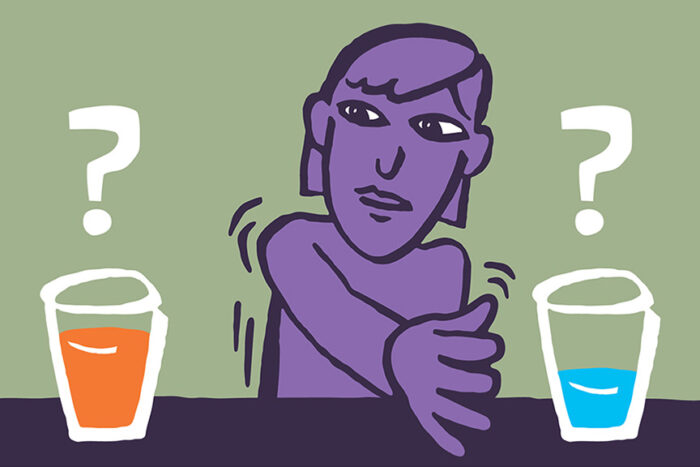New insight into how brain neurons influence choices
Effort could aid study of addiction, eating disorders, other neuropsychiatric conditions that involve faulty decision-making
 Mike Worful
Mike WorfulBy studying animals choosing between two drink options, researchers at Washington University School of Medicine in St. Louis have discovered that the activity of certain neurons in the brain leads directly to the choice of one option over another. The findings could lead to better understanding of how decision-making goes wrong in conditions such as addiction and depression.
When you are faced with a choice — say, whether to have ice cream or chocolate cake for dessert — sets of brain cells just above your eyes fire as you weigh your options. Animal studies have shown that each option activates a distinct set of neurons in the brain. The more enticing the offer, the faster the corresponding neurons fire.
Now, a study in monkeys by researchers at Washington University School of Medicine in St. Louis has shown that the activity of these neurons encodes the value of the options and determines the final decision. In the experiments, researchers let animals choose between different juice flavors. By changing the neurons’ activity, the researchers changed how appealing the monkeys found each option, leading the animals to make different choices. The study is published Nov. 2 in the journal Nature.
A detailed understanding of how options are valued and choices are made in the brain will help us understand how decision-making goes wrong in people with conditions such as addiction, eating disorders, depression and schizophrenia.
“In a number of mental and neuropsychiatric disorders, patients consistently make poor choices, but we don’t understand exactly why,” said senior author Camillo Padoa-Schioppa, PhD, a professor of neuroscience, of economics and of biomedical engineering. “Now we have located one critical piece of this puzzle. As we shed light on the neural mechanisms underlying choices, we’ll gain a deeper understanding of these disorders.”
In the 18th century, economists Daniel Bernoulli, Adam Smith and Jeremy Bentham suggested that people choose among options by computing the subjective value of each offer, taking into consideration factors such as quantity, quality, cost and the probability of actually receiving the promised offer. Once computed, values would be compared to make a decision. It took nearly three centuries to find the first concrete evidence of such calculations and comparisons in the brain. In 2006, Padoa-Schioppa and John Assad, PhD, a professor of neurobiology at Harvard Medical School, published a groundbreaking paper in Nature describing the discovery of neurons that encode the subjective value offered and chosen goods. The neurons were found in the orbitofrontal cortex, an area of the brain just above the eyes involved in goal-directed behavior.
At the time, though, they were unable to demonstrate that the values encoded in the brain led directly to choosing one option over another.
“We found neurons encoding subjective values, but value signals can guide all sorts of behaviors, not just choice,” Padoa-Schioppa said. “They can guide learning, emotion, perceptual attention, and aspects of motor control. We needed to show that value signals in a particular brain region guide choices.”
To examine the connection between values encoded by neurons and choice behavior, researchers performed two experiments. The study was conducted by first authors Sébastien Ballesta, PhD, then a postdoctoral researcher, and Weikang Shi, a graduate student, with the help of Katherine Conen, PhD, then a graduate student, who designed one of the experiments. Ballesta is now an associate professor at the University of Strasbourg in Strasbourg, France; Conen is now at Brown University.
In one experiment, the researchers repeatedly presented monkeys with two drinks and recorded the animals’ selections. The drinks were offered in varying amounts and included lemonade, grape juice, cherry juice, peach juice, fruit punch, apple juice, cranberry juice, peppermint tea, kiwi punch, watermelon juice and salted water. The monkeys often preferred one flavor over another, but they also liked to get more rather than less, so their decisions were not always easy. Each monkey indicated its choice by glancing toward it, and the chosen drink was delivered.
Then, the researchers placed tiny electrodes in each monkey’s orbitofrontal cortex. The electrodes painlessly stimulate the neurons that represent the value of each option. When the researchers delivered a low current through the electrodes while a monkey was offered two drinks, neurons dedicated to both options began to fire faster. From the perspective of the monkey, this meant that both options became more appealing but, because of the way values are encoded in the brain, the appeal of one option increased more than that of the other. The upshot is that low-level stimulation made the animal more likely to choose one particular option, in a predictable way.
In another experiment, the monkeys saw first one option, then the other, before they made a choice. Delivering a higher current while the monkey was considering one option disrupted the computation of value taking place at that time, making the monkey more likely to choose whichever option was not disrupted. This result indicates that values computed in the orbitofrontal cortex are a necessary part of making a choice.
“When it comes to this kind of choices, the monkey brain and the human brain appear very similar,” Padoa-Schioppa said. “We think that this same neural circuit underlies all sorts of choices people make, such as between different dishes on a restaurant menu, financial investments, or candidates in an election. Even major life decisions like which career to choose or whom to marry probably utilize this circuit. Every time a choice is based on subjective preferences, this neural circuit is responsible for it.”






